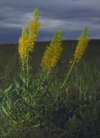Selenium toxicosis Flashcards
T/F: Overdosing selenium deficiency treatment can lead to selenium toxicosis
TRUE
What levels are considered selenium deficient?
<0.05 ppm
Selenium deficiency diseases?
- White muscle disease (WMD) or nutritional muscle dystrophy (NMD) in lambs, but also seen in calves and foals
- Hepatosis dietetica in young pigs
- Exudative diathesis in chicks
- Nutritional pancreatic atrophy in chickens
- Porcine stress syndrome in pigs
Where is selenium deficient soil common?
- Northwest
- Northeast
- Southeast
- Great lakes
What level of selenium qualifies soil as selenium-rich? Where is it located?
- 2-10 ppm
- South Dakota
- North Dakota
- Wyoming
- Montana
- Nebraska
- Kansas
- Utah
- Colorado
- New Mexico
What are the selenium requirements?
0.1 mg/kg (depends on vitamin E)
Remember: 0.1mg/kg = 0.1ppm
What are the various uses for selenium?
- Feed supplements for cattle, sheep, swine, and poultry
- Injectable selenium-vitamin E preparations
- Antioxidant supplements (animal and human)
- Used in medical shampoos for treatment of dermatitis
Sources of selenium?
- Cattle, sheep, and horses may graze seleniferous plants
- Swine and poultry may eat grains grown on selenium-rich soil
What are seleniferous plants? What are the various types?
Plants that accumulate Se in Se-rich soil
Obligate accumulators (Se-indicator plants), facultative accumulators, and passive accumulators
How much Se can obligate accumulators accumulate?
Up to 15,000 ppm Se
T/F: Obligate Se accumulators require Se for growth
TRUE
What plants are obligate accumulators of Se?
- Astragalus (locoweed, milk vetch)
- Stanleya (prince’s plume)
- Oonopsis (golden wood)
- Xylorrhiza (woody aster)
How much Se can facultative accumulators collect?
Accumulate up to 25-100 ppm
Do facultative accumulators require Se?
Nope, but they can accumulate it
Examples of facultative accumulators?
- Aster
- Atriplex (saltbush)
- Castilleja (paint brush)
Passive accumulators: Se levels?
Accumulate up to 1-25 ppm Se
Where do passive accumulators build up Se?
Accumulate Se passively in Se-rich soil
Examples of passive Se accumulators?
Many plants including crop plants such as corn, wheat, oats, barley, grass, hay, and other plants
Causes of Se toxicosis?
- Overdosage w/ Se preparations or supplements
- Se-contaminate water causes teratogenic effects in waterfowl
- Improper use of Se-medicated shampoos may cause toxicosis in small animals
What is this?

Astragalus (locoweed)

What is this?

Astragalus (milkvetch)

What is this?

Stanleya pinnata (prince’s plume)
T/F: Se is a non-essential trace element
FALSE–it is an essential trace element
What 3 states does Se have?
3 oxidation states: selenate (+6), selenite (+4), and selenide (+2)



